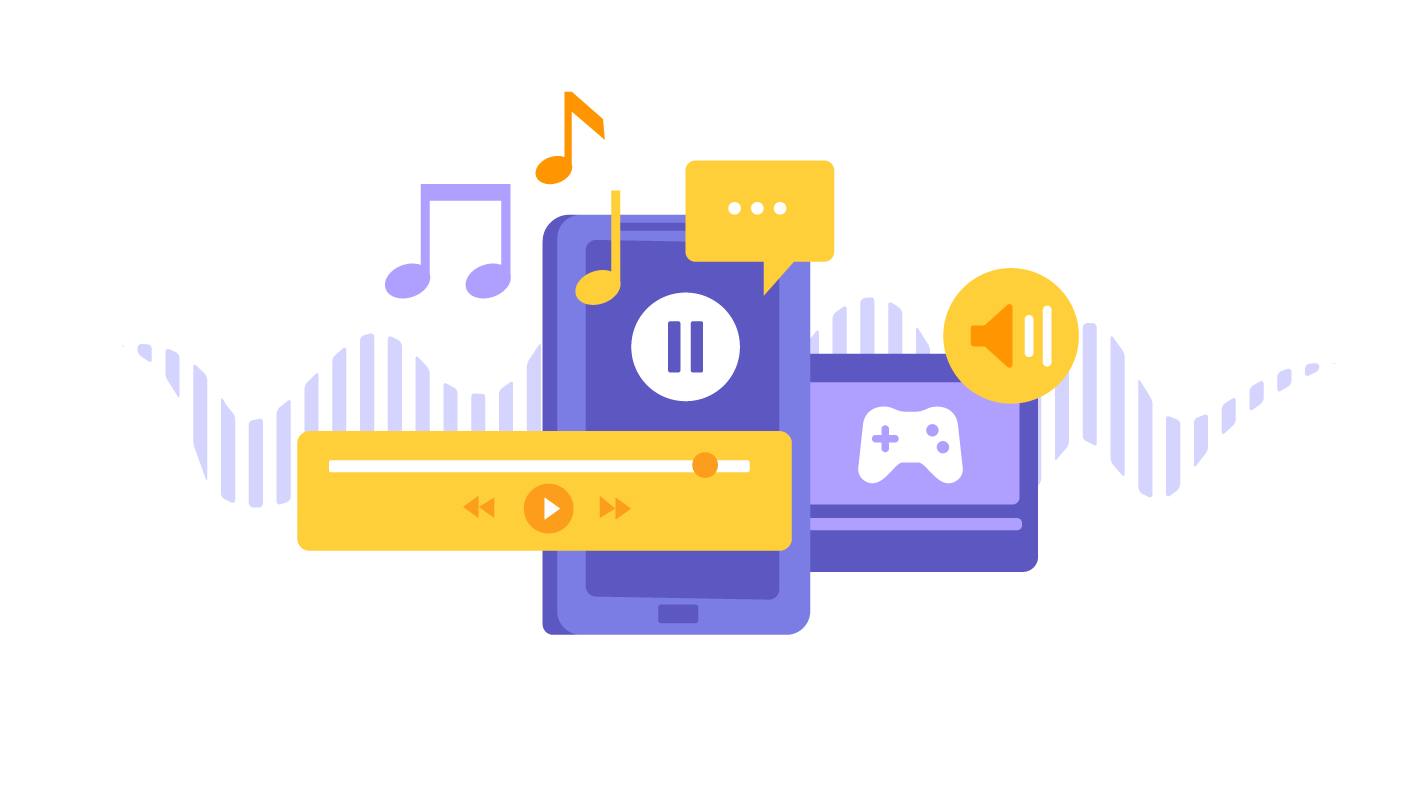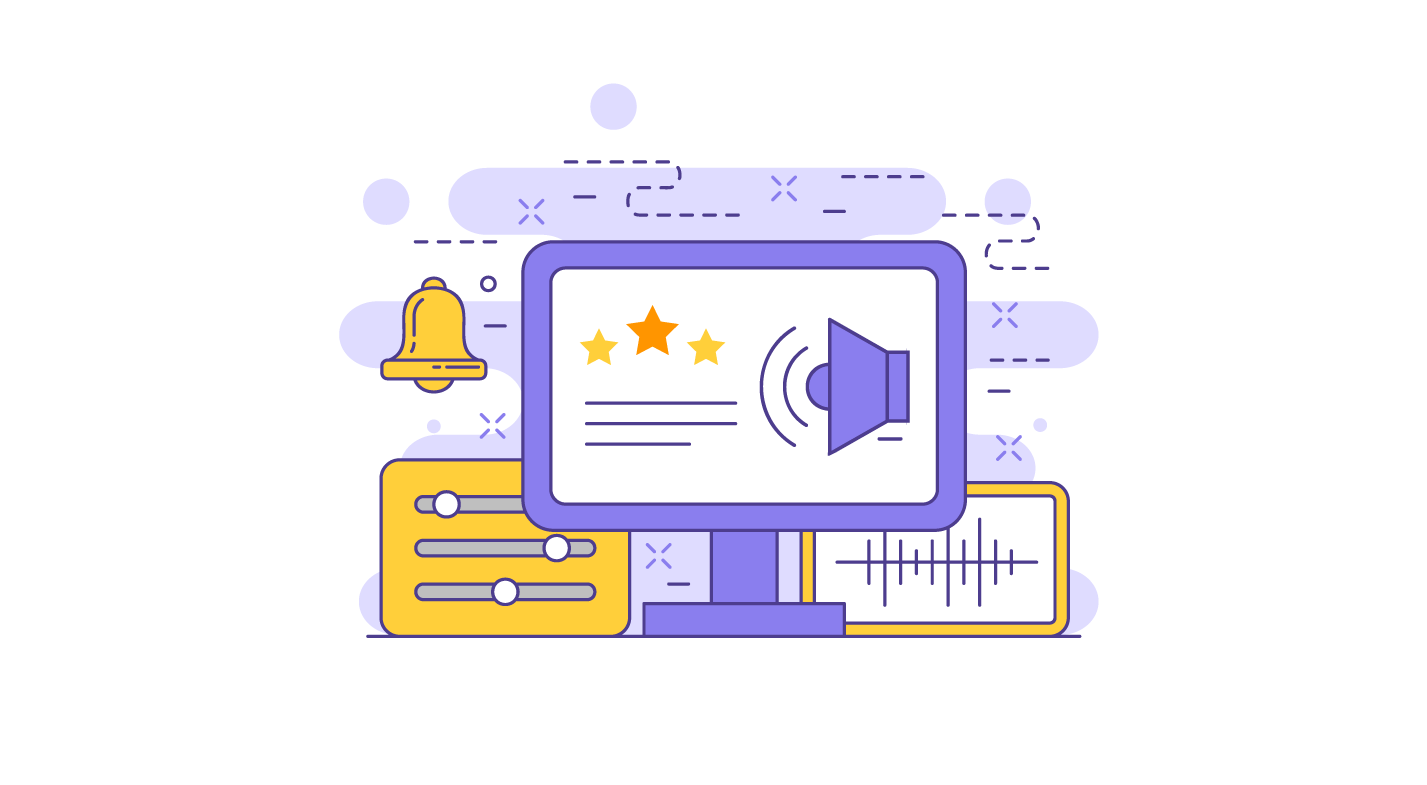

New York Radio Station aired the first ever radio commercial on August 28, 1922. Since then, audio advertisement has become synonymous with live radio. But with more of us engaging with audio content in the form of music streaming, podcasts, digital radio, and in-game audio, the digital age is starting to claim audio advertising on an impressive scale.
The number of Americans streaming audio content has more than doubled since 2012. Digital audio advertising grew by 57.5% in 2021 and ad spend is forecast to reach 8.95 billion dollars in 2023. It’s now the fastest-growing advertising format and a rapidly increasing number of brands are introducing audio ads as part of their overall marketing strategies.
So, what exactly does audio advertising mean and what are the key benefits, trends, and challenges facing this growing industry?
Let’s find out.
As the name suggests, audio advertising involves serving ads in an audio format. Traditionally this would have meant via radio stations, but these days audio adverts are delivered through online streaming platforms such as Spotify and YouTube, podcast platforms like Acast, and as part of in-game ad placements.
We’re surrounded by streamable content. Whether it’s listening to music on a run or catching up on a podcast during the daily commute. It’s not surprising then, that the leading global platform for music and podcast consumption, Spotify, generated approximately 1.4 billion U.S dollars in advertising revenue in 2022 - a figure that’s set to grow to 2 billion by 2026.
Spotify hosts audio ads which play for 30-60 seconds between songs and during podcasts. Other channels facilitating audio ads include Acast, Stitcher, YouTube, Sonos, Apple Music, Amazon Music, and iHeartRadio - to name a few.
More accessible than traditional radio ads, digital audio advertising is broadening audience reach and providing advertisers with opportunities for even better targeting (advertisers can choose to deliver their ads alongside select artists, podcasts, or digital radio shows that align with the interests of their target audiences).
There are two types of audio advertising models: direct and programmatic.
Involves manually negotiating on and buying audio ad inventory, and serving it on the desired platform. Under a direct approach, ad inventory and ad space are price negotiable and, because ad placement is individually tailored, it can lead to higher cost per thousand impressions, known as ‘cost per mile’ (CPMs). So, whilst direct advertising offers high levels of targeting and premium ad inventory, the buying and selling of this inventory can be a slow and expensive process.
Involves buying ad inventory via real-time bidding. This is an automated process in which bids are placed simultaneously and the highest bidder wins the inventory slot. Unlike direct advertising which requires a lot of manual communication and negotiation, programmatic requires minimal human involvement. Advertisers simply set audience, budget, and placement parameters for each campaign.
Programmatic advertising has been extremely successful across advertising mediums and is now the preferred method for digital audio transactions. Nearly three-quarters of media experts and 93% of publishers transact audio ads programmatically.
Programmatic audio is also helping advertisers establish an omnichannel advertising strategy but, according to Joshua Wilson, commercial director for Japan and Asia Pacific at Crimtan, there’s still a lot of learning to do and “platforms, such as Spotify and Acast, need to help advertisers understand the benefits of the channel and the right approach to make audio buys”.

For many years, programmatic audio advertising has lived in the shadow of programmatic display advertising, which is set to reach a whopping $141.96 billion in the U.S. in 2023. This difference in popularity is largely due to limited publisher interest in programmatic audio and the lack of adequate technology to facilitate delivery. As a result, advertisers and publishers were reluctant to invest.
This all began to change in 2014 when the digital advertising association, IAB, created an ad-serving protocol - the Digital Video Ad Serving Template (or VAST for short). The adoption of this framework created a common language for advertisers and publishers. By 2018, VAST was updated to include an “adType” attribution that allowed audio-only advertisements.
The audio ad took three forms, companion ads (banner ads displayed in the audio player whilst an audio ad is playing), ad pods (audio ads played at designated slots during content), and skippable ads (in-audio pre-roll and mid-roll advertisements).
VAST catalyzed a wider adoption of programmatic audio advertising and today the framework is thriving. The growth of audio advertising has been a gradual one but that doesn’t negate its impact. In a world where audio content is everywhere, the effectiveness of audio advertising is finally being noticed and companies like Google, Pandora, Acast, and adtech provider, Rubicon, are starting to deliver programmatic audio ads on their platforms.
46% of people now pay for subscriptions to streaming services such as Spotify and Apple Music and in 2022, listeners spent on average 20.1 hours each week playing their favorite music, up from 18.4 hours in 2021. And that’s why audio advertising is so effective. Audio ads have the opportunity to target a willing, engaged, and consistent audience.
Besides the overwhelming prevalence of audio listeners today, there are many other benefits to investing in audio advertising:
Since the majority of listeners access audio content through headphones, audio ads can command the attention of listeners in a way other mediums can’t. The repetitive nature of these ads also helps. Speaking to reporters at The Drum, AdTonos’ founder and CEO, Michal Marcinik describes audio as “an engaging, one-to-one form of communication” that “gives brands the opportunity to build a relationship with the listener”. Now, interactive voice recognition tools like Alexa, Siri, and Google Home are taking relationship building even further by encouraging two-way conversations, paving the way for a time when “information, services and products purchased online will be ordered by voice”.
As well as forging connections, audio ads also boost positive perceptions of brands and encourage listeners to take buying action, according to a nationwide study undertaken by independent research company, Tapestry. The Guardian-backed study revealed that “podcast advertising commands the highest levels of attention of any media channel” and that “65% of listeners paid attention to podcast adverts - more than adverts on TV at 39% and adverts on the radio at 38%” - attrition rates that translate to a higher chance of purchase.
Audio ads also lend themselves to highly granular targeting. For example, an advertiser can feature an ad on a particular online radio show, artist channel, or podcast that best aligns with the interests of its target customer. Acast recently took the granular capabilities of podcast advertising even further by launching keyword targeting on its Acast Marketplace platform.
The addition provides advertisers with an opportunity to “align their message with the most contextually relevant content spoken about within an episode. This significantly increases targeting relevance, reduces wastage, and results in a more contextually relevant advertising experience for listeners”. In practice, this means advertisers can target contextually relevant conversations within any show - even if that show sits within a totally different topic category.
Audio advertising plays into the hand of our mobile-first world. The vast majority of audio listening takes place via mobile and the time people spend listening to spoken word audio on mobile devices has almost tripled since 2014. In fact, Edison Research found that smartphones vastly outnumbered desktops and laptops as the device used to listen to podcasts “most often”. And, as one of the most profitable mediums for audio ads, that’s great news for advertisers.
In addition, there are a wide range of digital publishers available for audio advertisers. As well as podcast and music streaming platforms, opportunities for audio ad space within video games, smart speakers, and traditionally video-based streaming platforms like YouTube are on the rise. In 2022, YouTube made audio ads available globally in Google Ads and Display, and Video 360. The change gives users the choice between watching or listening and advertisers the opportunity to reach wider audiences.

As programmatic ads take off, and advertisers start to better understand its benefits, it’s likely that even more advertisers and publishers will embrace audio ads. As the medium gains traction, we can expect a broader range of offerings, such as:
Interactive ads are set to be the next big iteration of audio advertising. The global smart speakers market is forecast to grow from $6.6 billion to $7.07 billion between 2022 and 2023, marking an annual growth rate (CAGR) of 7.1%. As more people adopt smart speakers in their homes it’s likely that the delivery of interactive ads (in which listeners talk back to their smart speakers to make purchases) will start to scale.
Digital advertising platform, AdTonos, recently launched YoursTruly, a solution that facilitates real-time interactions between listeners and advertisers via smart speakers. The solution currently works on Echo devices, mobile devices, and smart speakers enabled with a voice assistant such as Alexa. Using YoursTruly, listeners can book products and services directly from an audio ad via voice command.
Historically, developers have shown a degree of caution around ads - mostly because of the potential negative impact of visual advertisements on the player experience. The question of whether gamers will accept in-game ads has been hot on every developer’s lips. But conversely, that presents a huge opportunity for audio ads which are generally less disruptive.
Advertising in an audio format means advertisers can reach gamers without interrupting gameplay. In 2022 there were 3.03 billion video gamers worldwide, so that’s nothing to be scoffed at. Companies the likes of AudioMob, Targetspot, and Odeoo are taking note of the opportunity that is non-intrusive audio advertising and have emerged as leaders in the space.
Last year in-game audio advertising platform Odeeo announced its integration with advertising marketplace Xandr. The integration allows demand-side platforms (DSPs) to capitalize on the casual games market by accessing Odeoo’s inventory of mobile games. The integration is one of the first of its kind and provides advertisers with a full view of traffic sources and viewability.
Looking to the future, Odeeo’s CEO, Amit Monheit is resolutely optimistic about the future of audio. In a statement made to Exchange Wire, Monheit comments that “in-game audio is the best way for advertisers to get attention”.
But the intrusiveness issue isn’t the only opportunity connected to in-game audio ads. There’s also the possibility of heightened personalization and gamification. Games lend themselves to reward methodologies. For instance, players could be incentivized and rewarded for listening to an ad with a prize (leveling up or unlocking a new feature, for instance) or targeted with highly personalized content that resonates with them.
Head of enterprise sales for Northern Europe at Spotify, Sally Keane, agrees. “What excites me about in-game audio ads is the huge potential to create immersive, engaging content that resonates deeply with users…as the video game industry continues to grow, there’s enormous potential for brands to reach this leaned-in, attentive audience,” comments Keane.
Audio ads are unlikely to be put into practice in isolation. Since most ads don’t typically drive immediate conversions, advertisers are looking to integrate audio as part of a broader omnichannel strategy. Connected media campaigns focus on the interconnectivity of media platforms and mediums. So, for example, an advertiser might choose to serve an audio ad alongside a connected banner ad to reinforce engagement and encourage clicks.
Many platforms are already doing this. Spotify audio ads are accompanied by display ads containing the advertiser’s name, a companion banner, and a call to action (CTA) button. Companion display ads encourage listeners to engage with the Spotify app and brand banner during ad breaks.
The success of audio does not negate the value of video streaming platforms like YouTube, Dailymotion, and Vimeo for advertisers. The global online video platform market was responsible for driving over 80% of total internet traffic in 2022 and is expected to reach a market size of 22.14 billion dollars by 2028. Video isn’t going anywhere, but that’s not to say that these platforms should ignore the strides being made by audio right now.
Quite the opposite. There are audio opportunities for video streaming platforms. As we already mentioned, YouTube rolled out audio ads to its advertisers last year. And in 2021, DailyMotion partnered with Targetspot to commercialize a new audio roll advertising format to facilitate the insertion of audio into online video.
Commenting on the development, chief revenue and business officer at Dailymotion Advertising, Bichoi Bashta, made the following comment: “giving advertisers the ability to target the on-line video viewer with an audio format in addition to traditional audio channels, allows them to cover the entire user journey and thereby multiply the impact of their campaigns”.

The future of audio advertising looks very bright indeed, but to say that no challenges lie ahead would be naive. Like all new developments, there will be obstacles to overcome. The decline of third-party cookies, for example, is putting the future direction of programmatic systems in question. Likewise, conflicting approaches to user targeting across platforms will need to be resolved. For example, whilst audio advertisers have tended to target users based on specific personas, game developers have historically steered clear of this level of granulation.
Other potential challenges include the foundational technologies behind programmatic audio which are not always compatible with existing digital ad-buying technologies, ad servers, and exchanges which were originally designed for visual ads. This becomes even more apparent when we think about the terminology attributed to such platforms (think cost-per-click, impressions, views, etc.,). Audio advertising doesn’t necessarily fit so easily into the mold.
And, as follows most innovations of this kind, there are a few security concerns. Some media professionals have vocalized reservations about potential digital audio ad fraud. Integral Ad Science surveyed digital media experts and found that 87% were concerned or very concerned about ad fraud in audio. That said, media experts remain hopeful that these security challenges can be overcome through adequate third-party verification processes.
From music streaming and podcasting platforms to traditionally video-based streaming platforms, the opportunities for audio ad space are just massive. Audio ads lend themselves perfectly to integration across a diverse range of platforms - platforms that are proven to harness engaged, interested audiences.
But for programmatic audio advertising to reach the dizzying heights of programmatic visual advertising there are still some early barriers to adoption that must be overcome. That said, the benefits and opportunities it offers are too good to ignore and audio advertising is definitely one of the adtech trends to watch. If initial teething problems can be overcome, we can say with some confidence that audio looks to be adtech’s next big offering.

Frances is proficient in taking complex information and turning it into engaging, digestible content that readers can enjoy. Whether it's a detailed report or a point-of-view piece, she loves using language to inform, entertain and provide value to readers.